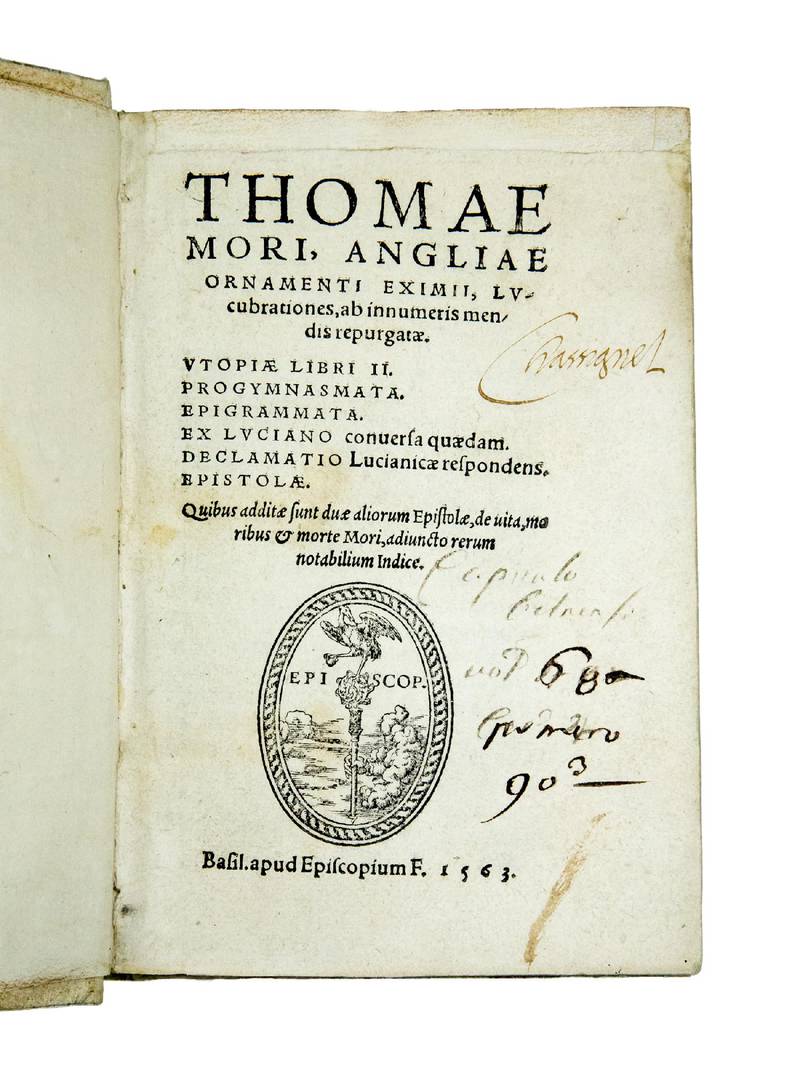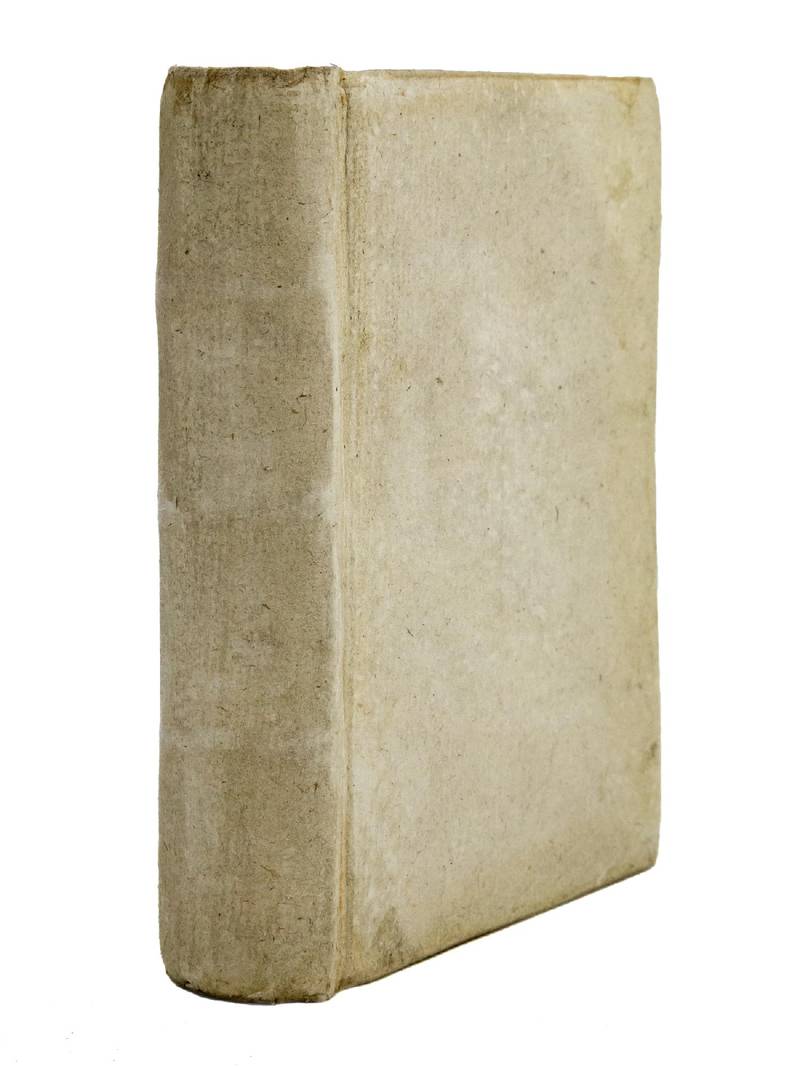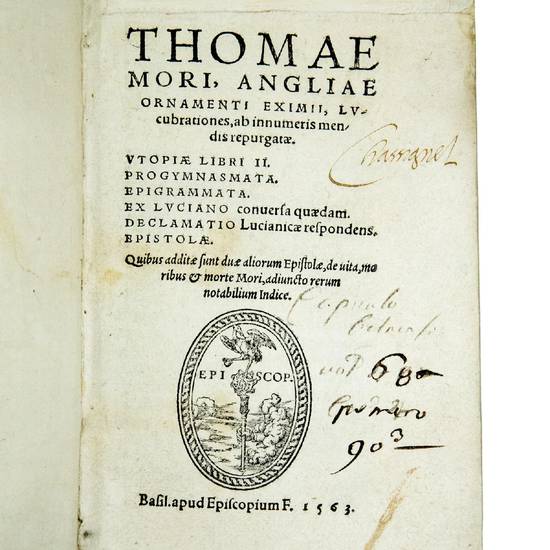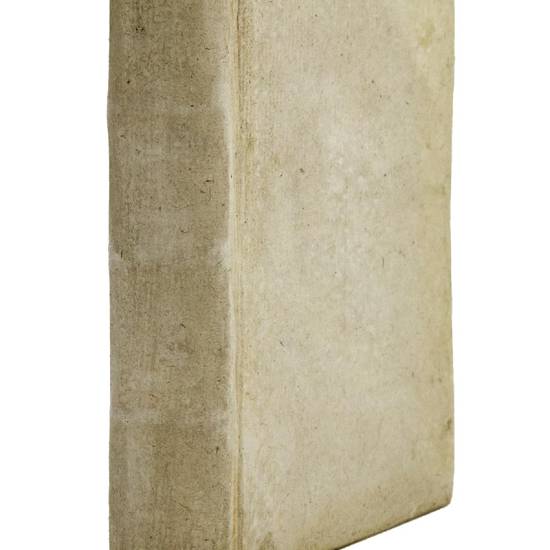Lucubrationes, ab innumeris mendis repurgatae. Utopiae libri II. Progymnasmata. Epigrammata. Ex Luciano conversa quaedam. Declamatio Lucianicae respondens. Epistolae. Quibus additae sunt duae aliorum Epistolae, de vita, moribus et morte Mori, adiuncto rerum notabilium Indice
Autore: MORE, Thomas (1478-1535)
Tipografo: Nikolaus Episcopius
Dati tipografici: Basel, 1563
8vo. (32), 530, (46) pp. α-β8, a-z8, A-N8. Lacking d3 (pp. 53-54) and N8, supplied in facsimile on old paper. With the printer's device on the title-page and at the end and a full-page woodcut map of Utopia on p. 53. Recased in modern cardboards.
Adams, M-1752; VD 16, M-6302; R.W. Gibson, St. Thomas More: a Preliminary Bibliography of his Works and Moreana to the Year 1700, (Hamden, CT, 1977), no. 74; Th. More, The Correspondence, E.F. Rogers, ed., (Princeton, NJ, 1947), pp. XV-XXII; B.J. Trapp & H. Schulte-Herbrüggen, ‘The King's Good Servant': Sir Thomas More, Exhibition Catalogue, (London, 1977), p. 133, no. 261.
FIRST COLLECTED EDITION of Thomas More's Latin works, in which are printed for the first time some of his letters.
The volume includes the two books of Utopia with the usual prefatory letters by Erasmus, Guillaume Budé, Pieter Gillis, and by More himself; More's and Lily's Progymnasmata; the Latin epigrams; More's translation of the dialogues of Lucian, along with his Declamatio in response to the latter; 13 letters by More, 1 letter addressed by Erasmus to Ulrich von Hutten on More's life, and 1 letter on More's death generally attributed to Gilbert Cousin, Philippus Montanus, and Eramsus himself.
Among More's letters stands out the famous long letter to Martin Dorp at Louvain dated October 21, 1515 (pp. 365-428), which is, in fact, a vindication of the ‘new learning', and a clear statement of More's intellectual credo. He considered the study of the Greek text of the New Testament much more desirable than the blind acceptance of the Vulgate. This statement was of considerable importance for the development of humanism and of Western thought generally (cf. J.H. Bentley, New Testament Scholarship at Louvain in the Early Sixteenth Century, in: “Studies in Medieval and Renaissance History”, new series, II, 1979, pp. 53-79).
Erasmus' letter to Hutten (pp. 497-510; cf. P.S. Allen, ed., Opus epistolarum Des. Erasmi, Oxford, 1922, IV, no. 999, pp. 12-23), first published in his Farrago nova epistolarum (Basel, 1519), gives a biography of More and a detailed description of his physical appearance. The final letter (pp. 511-530), signed by Covrinus Nucerinus (clearly a pseudonym) and addressed to Philippus Montanus, a pupil of Erasmus, is concerned with More's trial and execution. It had appeared for the first time without place of publication and printer's name, but had actually been printed by Hieronymus Froben in Basel in 1535 (cf. P.S. Allen, ed., Opus epistolarum Des. Erasmi, Oxford, 1947, XI, app. XXVII, pp. 368-378).
“Only ninety-three of More's Latin letters (among them four written under pseudonyms) survive, counting the familiar, the public, and everything in between […] Some of More's letters were suppressed, lost, or destroyed for political reasons, which makes the recent discovery of a manuscript bundle that belonged to Frans van Cranevelt and includes seven hitherto unknown letters by More an extraordinary event. But More himself, in this respect unlike Erasmus, does not seem to have tried to publish his letters (or have them published) as a collection, although clearly he kept copies. In fact, on occasion he withheld publication. In 1520, for instance, he wrote William Budé and asked him not to publish his letters to him, at least until he had revised them, […] In any case, More's situation differed from someone like Erasmus, despite his connections with him. More wrote some of his best-known familiar letters (and most of his official letters) in English, not Latin. Additionally, he was a busy lawyer, judge, administrator, and statesman; humanism was never the whole of his life, and his projections of self and life are multiple, even disparate. To put this another way, More depended much less than Erasmus did upon representing himself as a man of letters, although he was attracted to that sort of life. In fact only twenty-four of More's letters were published – that is, printed – during his lifetime, and many of his familiar letters were printed for the first time in 1588 by Thomas Stapleton, who had access to More's manuscript correspondence through connections with the family. But almost all the Latin letters that were printed or otherwise circulated before More was executed are linked with Erasmus and/or Erasmian humanism. Despite the many gaps and their relatively small number, then, More's extant Latin letters are an integral part of his humanism and his humanist self or selves. More wrote his first Latin letter we know of in about 1501 and his last one in 1535, while imprisoned in the Tower of London; this means that they span almost his entire adult life. But most are dated between 1515 and 1524, when he was most fully engaged as a humanist and was closely associated with Erasmus. Numerically, too, Erasmus is the most important of some thirty addresses: twenty-four Latin letters are addressed to him. Cranevelt follows, with thirteen, then More's daughter, Margaret Roper, with his other children (in some instances) or his ‘school', with nine. Then the count drops; there are four to Budé and John Cochlaeus and three to John Fisher, Peter Giles, Edward Lee, and Cuthbert Tunstall. Formally there is a great range: brief notes and compliments; many longer familiar or quasi-familiar letters, among them letters of dedication, prefaces to published works, and partly or wholly fictional letters; a verse epistle; and six extremely long essay-letters - that is, extended open letters on intellectual, literary, and religious issues” (E. McCutcheon, The Humanism of Thomas More: Continuities and Transformations in His Latin Letters, in: “Acta Conventus Neo-Latini Bariensis”, Tempe, AZ, 1998, pp. 27-29).
Dorp, Martin. Bruges, [October 21, 1515] (p. 365)
Erasmus, Desiderius. [Greenwich?, March-April, 1520] (p. 429)
id. [London, Februay 17, 1516] (p. 455)
Gillis, Pieter (Aegidius, Petrus). [Calais, October 7, 1517] (p. 463)
Erasmus, Desiderius. [Calais, November 5, 1517] (p. 465)
id. [London, August 19, 1517] (p. 467)
id. [Calais, October 25, 1517] (p. 469)
id. [Canterbury, May 26, 1520] (p. 470)
id. [Greenwich, April, 1520] (p. 474)
id. [Greenwich?, May, 1520] (p. 476)
id. [Chelsea, June 14, 1532] (p. 484)
Tabula affixa ad sepulchrum Thomae Mori (p. 489)
Erasmus, Desiderius. [Chelsea, June?, 1533] (p. 491)
[Bonvisi, Antonio] (Exemplar epistolae Thomae Mori, in carcere carbone Lovaniensi cuidam scriptae). [Tower of London, 1535] (p. 494)
from Erasmus, Desiderius to Hutten, Ulrich von. Antwerp, July 23, 1519 (p. 497)
from Covrinus Nucerinus to Montanus, Philippus. Paris, July 23, 1535 (p. 511)
Thomas More was educated in London, his hometown, at St. Anthony's School and then as a page in the household of John Morton, archbishop of Canterbury. After attending for two years the University of Oxford, around 1494 he began to study the English common law in London. In the following years he became a lawyer and a royal servant, but in the same period he started to learn Greek under Thomas Linacre.
In 1504 he was elected member of the parliament. Between 1510 and 1519 he was under-sheriff of London, and in 1515 he was sent as a member of an embassy to Flanders, where he began to compose Utopia. In 1517 he undertook a diplomatic mission to Calais, and a year later he entered the king's service as a judge and a councilor. In 1521 he was knighted and named under-treasurer of the king's exchequer, and in 1523 he was appointed speaker of the house of parliament. In 1525 he became the chancellor of the Duchy of Lancaster, and in 1529 he received the great seal from the king and became lord chancellor until he resigned in 1532 after the so-called ‘Submission of the Clergy', which subjected the holding of synods to royal approval.
In the following two years More spent his time writing polemic pamphlets in defense of orthodoxy and the church, notably the Apologia. In 1534 after refusing to subscribe to the new oath required by the Act of Succession, he was imprisoned in the Tower, where he wrote many devotional works, among which the Dialogue of Comfort. On July 1, 1535 he was tried for treason and convicted. The day after he was beheaded and his head was exhibited on London Bridge (cf. R.J. Schoeck, The Achievement of Thomas More: Aspects of his Life and Works, Victoria, BC, 1976, passim).
Erasmus became one of More's closest friends. They met for the first time in 1499, during Erasmus' first visit to England. From then on their friendship quickly deepened and continued until death. They exchanged a massive correspondence and influenced each other. All More's early humanistic works, including Utopia, are the result of a close collaboration with Erasmus and, conversely, a number of the latter's writing bear marks of More's thought (cf. E.E. Reynolds, Thomas More and Erasmus, London, 1965, passim).
[9066]





